

The inventors of the Pentagon: of the science fiction in the reality
1 – Remote-controlled insect
This beetle is a spy. Electrodes in his brain make of him a guided insect. A giant flower beetle wears an electronic backpack that allows researchers to wirelessly control its flight. [Credit: Hirotaka Sato and Michel Maharbiz, University of California, Berkeley]
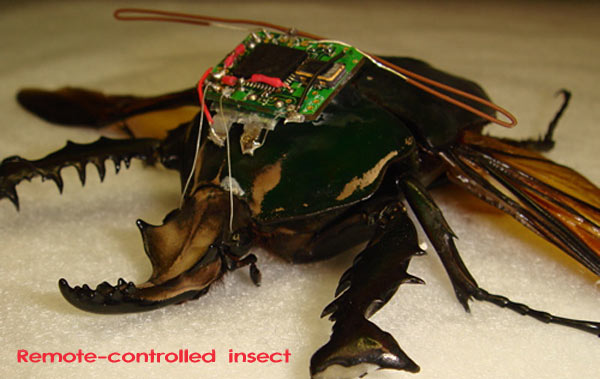
In a large, empty room at the University of California, Berkeley, a giant flower beetle sits on the floor. Like most beetles, it has a segmented body, six legs, and a pair of wings. But there’s something a little different about this one: it’s wearing an electronic backpack that’s wired to its wing muscles and brain.
An engineer in the room taps a button on his laptop and instantly the beetle’s wings begin to vibrate, rousing it into flight. Pressing another key stops all wing movement mid-flight. The beetle drops to the floor — a little stunned, perhaps, but unharmed. If it sounds too bizarre to be true, just check out this video on YouTube or view it below.
Read More: Source
2 – Hypersound plane
The bird is called Falcon HTV-2 and has already lived a test flight. It is capable of moving in a 26 000 kph speed, that is the crossing of the United States in 12 minutes.
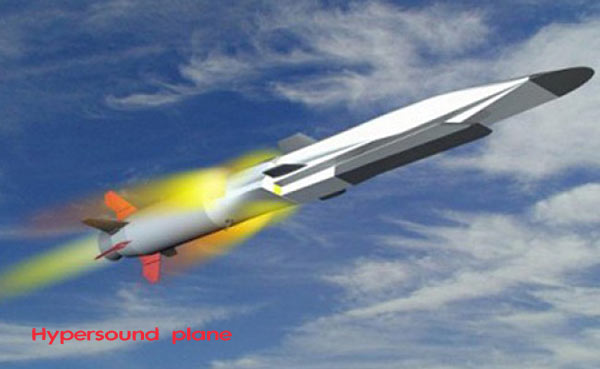
The DARPA, the agency of the Pentagon specialized in the emergent technologies, had to make steal, on Thursday, its hypersound plane Falcon HTV-2, a monster capable of moving in 26 000 kph and thus of crossing the United States in 12 minutes! The machine must be thrown since the base of Vandenberg, in California, by a rocket to the very military speeds. Not surprising: it is about a by-product of the strategic missile LGM-118 Peacekeeper, of Martin Marietta, removed from the service by the US Air Forces in 2005.
Henceforth conscript Minautor IV Lite, this thrower is exploited by the company Orbital Sciences. He takes Falcon HTV-2 in his headgear. When it opens, the automatic plane begins its flight to Mach 20. This flight would be the second realized by Falcon. He has to serve to validate his instrumentation and to refine the studies on the aerodynamic and thermal aspects of the hypersound flight, which produces a heat superior to 2 000 °. The equipments of communication, control and navigation owed.
Read More : Source
3 – Neuronal interface
It is past the time when prostheses were only sluggish repercussions. Thanks to a neuronal interface, the prostheses of Darpa are articulated and directly ordered by the brain of the carrier.
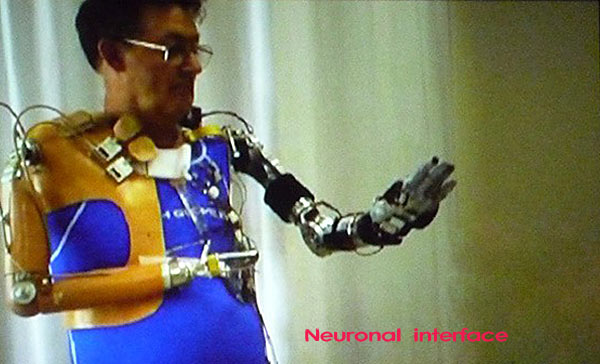
The Revolutionizing Prosthetics program will create a fully functional (motor and sensory) upper limb that responds to direct neural control, within this decade. This revolution will occur by capitalizing on previous DARPA investments in neuroscience, robotics, sensors, power systems, and actuation. In particular, this program builds on DARPA’s Human-Assisted Neural Devices program, which recently decoded the brain’s motor signals with such fidelity that movements of a robotic arm can be controlled entirely by direct brain control.
Revolutionizing Prosthetics research teams from DEKA Integrated Solutions Corporation and Johns Hopkins APL recently updated representatives from more than 10 federal agencies on their efforts—including advances in socket systems and implantable devices that will be used to allow direct brain control of the arms by amputees and by others affected by stroke, spinal cord injury or neural degenerative disorders. The update included a review of the lessons learned from DEKA’s amputee trials in Manchester and from participants in a Department of Veterans Affairs-led study at VA medical centers in New York and Tampa, and at the Center for the Intrepid at Brooke Army Medical Center in San Antonio; over thirty-one volunteer provided feedback for the development of the DEKA Gen-3 Arm System.
Read More : Source
4 – Nanodrone
Drones take a more and more important part on the grounds of fight, we were able to see it in Libya or in Iraq. Soon, they can have the size of a hummingbird and move easily in town, or even indoor.
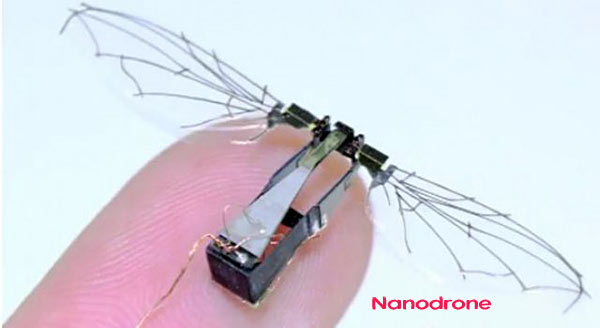
The Nano Air Vehicle (NAV) program is developing an extremely small, ultra lightweight air vehicle system (less than 15 centimeters and less than 20 grams) with the potential to perform indoor and outdoor military missions. NAV is exploring novel, flapping wing and other configurations to provide warfighters with unprecedented capability during urban operations.
NAV will push the limits of aerodynamics, power conversion efficiency, endurance and maneuverability for very small air vehicle systems. These platforms will be revolutionary in their ability to harness low Reynolds number physics, navigate in complex environments, and communicate over significant distances. Flight-enabling nano air technologies include aerodynamic design tools to achieve high lift-to-drag airfoils; lightweight, efficient propulsion and power systems; guidance, navigations and communication subsystems; and advanced manufacturing and innovative subsystem packaging and configurations layouts.
Read More : Source
5 – Boosted learning
We all dreamed to learn the Latin declensions in three minutes. The program of Darpa aims, thanks to the neurosciences, at optimizing radically the apprenticeship by deactivating magnetically certain functions of the brain.

Warfighters must master a diverse set of physical and mental skills, often in a very compressed period. Measures of learning in this military environment often rely on qualitative and subjective assessment, with little opportunity to correct or redirect learning in midcourse. Recent discoveries in neuroscience, modeling and analysis techniques laid the foundation for neuroscience-based noninvasive strategies with potential to dramatically accelerate transition from novice to expert in key military tasks. The Accelerated Learning program will develop quantitative and integrative neuroscience-based approaches for measuring, tracking and accelerating skill acquisition while producing a twofold increase in an individual’s progress through the stages of task learning. Accelerated Learning will identify the neural basis of expert performance by integrating behavioral data with neurophysiological measures to track the progression of novices on the training path to expertise.
Accelerated Learning will develop reliable, quantitative methods to track task progression based on noninvasive measures of brain activity, including neurophysiologically driven training regimens, neurally optimized stimuli and stimulatory or modulatory interventions. Complementary components to help attain this goal include development of neurally based techniques to maintain acquired skills, prediction of skill acquisition based on real-time neural activity, preferential brain network activation, and strategies for understanding relationships between cognition and emotion in skills learning.
Read More : Source
6 – Dog robot
BigDog – The Most Advanced Rough-Terrain Robot on Earth. BigDog is capable of walking on all the surfaces, and even of restoring his balance without falling when we kick him in the side. It sniffs, is capable of recognizing the ground and is possible carry 100 kilos.
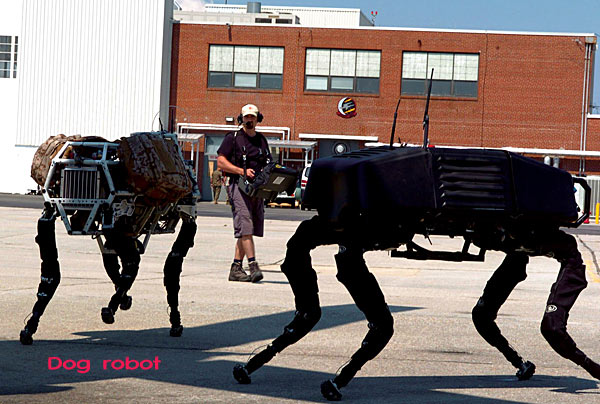
BigDog is the alpha male of the Boston Dynamics robots. It is a rough-terrain robot that walks, runs, climbs and carries heavy loads. BigDog is powered by an engine that drives a hydraulic actuation system. BigDog has four legs that are articulated like an animal’s, with compliant elements to absorb shock and recycle energy from one step to the next. BigDog is the size of a large dog or small mule; about 3 feet long, 2.5 feet tall and weighs 240 lbs…
Read More: Source
7 – Programmable material
Imagine a material which, on an impulse, exchange of shape and becomes the chosen object? It is the project on which Darpa works which ends, for the moment, in an origami which complies alone.
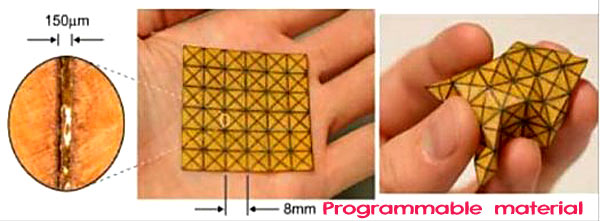
The Programmable Matter effort represents the convergence of chemistry, information theory and control into a new materials design paradigm—“InfoChemistry”—that focuses on building information directly into materials.
To achieve the Programmable Matter vision, key technological breakthroughs will center on the following critical areas:
- Encoding information into chemistry or fusing materials with machines
- Fabrication of mesoscale particles with arbitrary complex shapes, composition, and function
- Interlocking/Adhesion mechanisms that are strong and reversible
- Global assembly strategies that translate information into action
- Mathematical theory for construction of 3D objects from particles
The goal of this program is to demonstrate a new functional form of matter, based on mesoscale particles, that can reversibly assemble into complex 3D objects upon external command. These 3D objects will exhibit all the functionality of their conventional counterparts. Of critical importance are radical new material architectures that maximize the efficiency of information processing and transfer and design rules for the optimal number, size and shape of particles required to create objects of a specific size, and spatial feature resolution.
Read More : Source
8 – Z-Man
While copying the lizard which the man will eventually walk on walls. Z-Man is a kind of miniature, but real Spiderman.
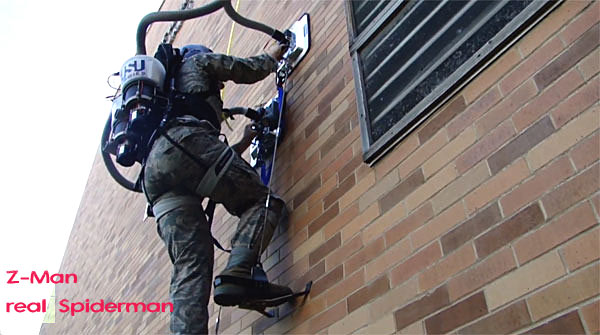
The Z-Man program will develop biologically inspired climbing aids to enable soldiers to scale vertical walls constructed from typical building materials, without using ropes or ladders. Geckos, spiders and small animals are the inspiration behind these climbing aids. These creatures scale vertical surfaces with unique systems that exhibit strong reversible adhesion via van der Waals forces or hook-into-surface asperities. Z-Man seeks to build synthetic versions of those biological systems, optimize them for efficient human climbing, and use them as novel climbing aids. The overall goal is to enable a soldier to scale a vertical surface while carrying a full combat load using Z-Man technologies.
Read More : Source
9 – Exoskeleton
Before, it was of the science fiction, today, the exosquelette really exists. It weighs 70 kilos, and allows to carry without any trouble its own weight and additional 90 kilos.
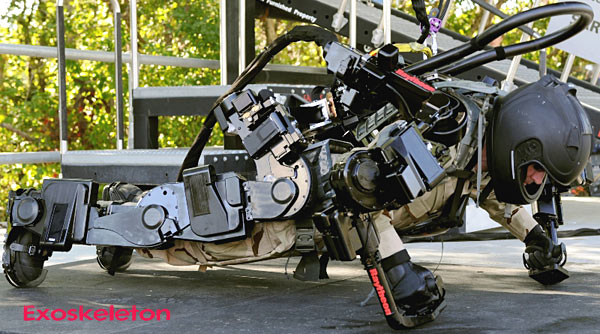
The widespread usage of exoskeletal robotics to augment human beings moved a step closer this week when Raytheon demonstrated its second generation Exoskeleton, the XOS 2. The new robotic suit (think of it as wearable robot guided by a human brain) is lighter, faster and stronger than the original proof-of-concept XOS 1, yet uses half the power.
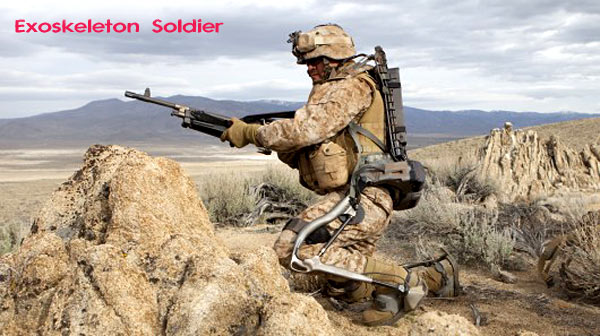
While Raytheon’s development is primarily focused on military usage, exoskeletons for the mobility-impaired are already at market and industrial exoskeletons from Japan, Korea and Isreal are not far behind. One day in the not-too-distant future, one of these suits will enable us all to have superhuman strength, speed and endurance…
Read More : Source














